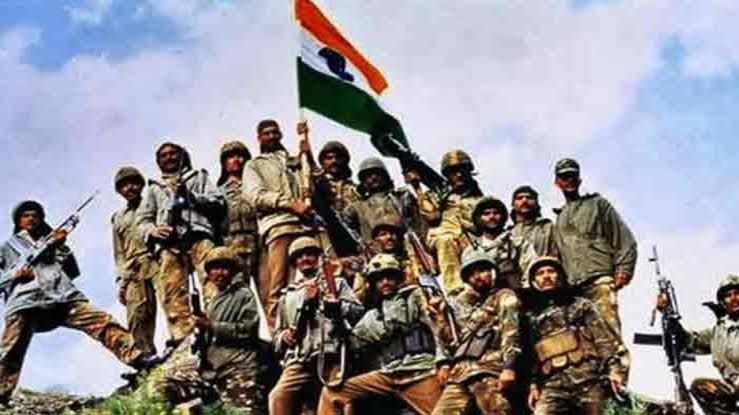The Kargil War stands as a poignant chapter in Indian history, forever etched in the collective memory of the nation. It honours the bravery and courage of the Kargil War Heroes who led Operation Vijay, which resulted in the victory of the Indian Armed Forces, even if it came at a high price. India celebrates this triumph every year on July 26 as Kargil Vijay Diwas, a sad festival meant to remember the valiant warriors who gave their lives in defense of their country.
A two-day event to mark the 24th Vijay Diwas will begin on July 25. Preparations are underway for the event at the War Memorial here, with final touches being added. The event will be graced by Defense Minister Rajnath Singh.
Operation Vijay
Before we move ahead with the importance of the event and its current relevance, let us take you through a little background of the operation Vijay and Kargil war.
- The Kargil conflict occurred in the Kargil district of Jammu & Kashmir, India, between May and July 1999.
- Infiltration and incursions by Pakistani soldiers and terrorists from Kashmir into the region of Kargil led to the start of the war.
- In order to get back the seized Kargil Heights, the Indian army started an operation known as “Operation Vijay”.
- With one of the most difficult terrains for fighting, the Kargil War was unique as it was fought at high elevations, around 18,000 feet.
- Over 700 Pakistani soldiers and 500 Indian soldiers, respectively, lost their lives during the fighting.
- Air power, infantry actions, and artillery were all heavily deployed during the war.
- During the fight, the Indian Air Force was essential in providing aerial support, carrying out vital airstrikes to drive the enemy out of key locations.
- A national hero for his bravery and audacity during the conflict was Indian Army Captain Vikram Batra. His catchphrase, “Yeh dil maange more,” has gained popularity.
- Throughout the conflict, the Indian Army reclaimed important summits such Tololing, Tiger Hill, and Point 4875.
- Since the Indo-Pakistani War of 1971, the two nations had not directly fought each other until the Kargil War.
- The military victory at Kargil against perfidious Pakistan brought global spotlight on cross-border terrorism practised by Islamabad.
- International pressure was applied to Pakistan to remove its soldiers from the area as a result of the conflict.
After winning back the important posts in Kargil the Indian Army did not just stop there, much has been changed since then, in terms of armament and other significant decisions to reshape India’s capabilities.
Lessons learned from the Kargil War
The then government in the centre was ruled by Atal Bihari Vajpayee. The idea was to reshape the national security and the team for the same was led by K Subramanyam, father of External Affairs Minister S Jaishankar.
- Some suggestions made by K Subramanyam include the appointment of a CDS. The post of Chief of Defence Staff (CDS) was proposed by the Subrahmanyam Committee when the NDA government under Atal Bihari Vajpayee was in power but it took two decades to implement the recommendation. On January 1, 2020, Prime Minister Narendra Modi appointed General Bipin Rawat as the first CDS of India.
- Indian Army reorganized its commands and raised a strike corps against China at Pannagarh to take on the PLA challenge.
- Reforms were also initiated in Indian intelligence with then Director, of the Intelligence Bureau, Ajit Doval setting up the multi-agency Centre (MAC) and joint task force on Intelligence (JTFI) during his short tenure in 2004.
- India started border infrastructure upgradation and literally exorcised the ghost of the 1962 war. Before the NDA took office at the centre, India never condemned the expansions made by the Chinese troops except for Atal ji and his Defence Minister George Fernandes. Just as in Kargil, the message today is that India under PM Narendra Modi will retaliate to any transgression and will defend its borders with all might.
- The decolonization of Indian bureaucracy is still a work in progress as decisions are processed not result-driven and are not in sync with the national interest.
- Last but not least, the Indian Army fell at the hands of Pakistani artillery at Kargil because it lacked laser-directed munitions, surveillance drones, and cannon-finding radars. The laser-guided bomb kits for monitoring and targeting were introduced at the last minute in the Drass area in June 1999. The radars were received from the US after the conflict, much as Israelis delivered Searcher drones.
- The “Atmanirbhar Bharat” programme has been strongly backed by PM Modi, however, Indian defence PSUs and hardware manufacturers are obstructing private sector entry and taking advantage of fifth columnists. In order for India to achieve its goal of being a developed country by 2047, a robust defence supply chain is necessary.
The Kargil Vijay Diwas
Kargil Vijay Diwas is an opportunity for all citizens across India to come together and express their gratitude towards those who risk their lives daily in protecting our nation from any external threat. It is a day to remember those brave soldiers who sacrificed their today for our tomorrow; a day when we must reaffirm our commitment to them and pledge never to forget their service or shirk from protecting our motherland. We must never let such brave souls fade away from memory but rather keep them alive by celebrating their courage and valour every Kargil Vijay Diwas!



















Comments